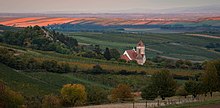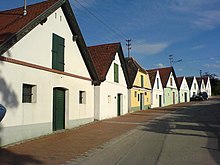Falkenstein (Lower Austria)
|
market community Falkenstein
|
||
|---|---|---|
| coat of arms | Austria map | |
|
|
||
| Basic data | ||
| Country: | Austria | |
| State : | Lower Austria | |
| Political District : | Mistelbach | |
| License plate : | MI | |
| Surface: | 19.19 km² | |
| Coordinates : | 48 ° 43 ' N , 16 ° 35' E | |
| Height : | 302 m above sea level A. | |
| Residents : | 480 (January 1, 2020) | |
| Population density : | 25 inhabitants per km² | |
| Postal code : | 2162 | |
| Area code : | 02554 | |
| Community code : | 3 16 08 | |
| NUTS region | AT125 | |
| Address of the municipal administration: |
Marktstrasse 60 2162 Falkenstein |
|
| Website: | ||
| politics | ||
| Mayor : | Leopold Richter ( ÖVP ) | |
|
Municipal Council : ( 2020 ) (13 members) |
||
| Location of Falkenstein in the Mistelbach district | ||
 Town hall in Falkenstein |
||
| Source: Municipal data from Statistics Austria | ||
Falkenstein is a market town with 480 inhabitants (as of January 1, 2020) in the Mistelbach district in Lower Austria .
geography
Falkenstein is located in the limestone cliff landscape of the northern Weinviertel in Lower Austria and geologically belongs to the Waschberg zone . To the south of the village, the Galgenberg rises to a height of 425 m.
The Jakobsweg Weinviertel , which has been signposted since 2010 and which leads from the Holy Mountain near Mikulova Svatý kopeček u Mikulova in the South Moravian town of Mikulov in Okres Břeclav to Krems an der Donau and is part of the Via Francigena and Via Slavica , leads through the municipality .
The area of the market town covers 19.17 square kilometers. 58.82 percent of the area is forested.
Community structure
There is only the Falkenstein cadastral community .
Neighboring communities
history
Prehistory and early history
Traces of settlement from the Neolithic, the Bronze Age and the La Tène Age have been found on the castle hill. In the Neolithic, there was an extensive fortification on the so-called Schanzboden, in the area of which there are also traces of Bronze Age and modern settlements. The Venus von Falkenstein is a painted, 13 cm high statuette of the Lengyel culture and dates from around 4,500 BC, it can be seen today in the Museum of Prehistory of the State of Lower Austria .
middle Ages
It is probably originally an autochthonous formation of the Counts of Neuburg-Falkenstein , who controlled extensive lands in Bavaria , Lower Austria and Tyrol during the Staufer period . The parish and church were built together with Falkenstein Castle around 1050 and were first mentioned together with Falkenstein Castle in 1120/22 in connection with Klosterneuburg Abbey. In 1135 it was named as one of the thirteen Babenberg parishes belonging to the Weinviertel mother parishes.
Falkenstein is towered over by the mighty castle ruins , its history is as old as the settlement of the Weinviertel under Emperor Heinrich III in the middle of the 11th century. Until the 16th century the castle was a feudal lordship and pledge of the sovereigns of Austria . In the 16th century the five churches held the pledge and introduced the Reformation.
There were two other castles in Falkenstein. The Rabenhof, which was converted into a citizen's hospital around 1380, today converted into a residential building and the core of the former rectory . Viticulture has always played an important role in Falkenstein . The Bergtaidingbuechl , a piece of legislation for viticulture from 1309, played a special role . As the seat of the Mining Authority (Weinberggericht), Falkenstein was responsible for all legal issues relating to wine in the area between Vienna and Brno .
County of Falkenstein

In 1571 the Falkenstein castle and estate were acquired by the Trautson family from Tyrol . Paul Sixtus von Trautson was appointed Imperial Count of Falkenstein by Emperor Rudolf II in 1598 and subsequently expanded the castle into a representative Renaissance fortress. From 1615 to 1620 Paul Sixtus set up a mint at the castle and minted his own talers and groschen here. In the town center, the town hall was built in the late Renaissance style . In 1645 the castle was conquered by the Swedes, but not destroyed. The decay did not set in until the end of the 17th century, in addition, the castle was used by its own owners as a quarry and demolished to extract building materials. The residence and administrative seat of the county was already at Poysbrunn Castle .
In 1670 the parish church of St. Jakob von den Trautson was rebuilt using older components. The facade in the early Baroque style characterizes the townscape from afar. The baroque Calvary with stations on the Passion story was created under Ernst Trautson .
In 1741 the community founded the Falkensteiner orphanage. This existed until 2004 as the Falkensteiner Privatlade as Austria's oldest financial institution and was then incorporated into the Raiffeisenbank Weinviertel.
When the Trautson family died out, the castle and the lordship fell to the Auersperg family and were acquired by the Bartenstein in 1799 . They built their family crypt next to the church . The castle passed to the Vrints family by inheritance. In 1860 Maximilian Vrints was raised to the rank of Count Vrints zu Falkenstein by Emperor Franz Joseph .
Second World War
During the Second World War , Falkenstein was the target of several air raids by Soviet fighter planes on April 20 and 21, 1945 , in which two residents were killed. A total of 18 residential and farm buildings were destroyed by fire. On April 22, 1945 soldiers of the Red Army marched into Falkenstein without a fight. After the end of the war, the Russians occupied the village until July 18, moving into a large camp in the nearby forest on Landmann , while they had taken quarters in the houses for the first few weeks after the end of the war.
Falkenstein today
In addition to agriculture and viticulture, tourism became an economic factor in Falkenstein. Under the current owner, Georg Thurn-Vrints, the castle ruins were reopened to visitors and an association for the preservation of the Falkenstein castle ruins was founded. Archaeological excavations have been carried out under the direction of the Federal Monuments Office since 1992.
coat of arms
The coat of arms of the imperial county Falkenstein was a falcon on a mountain of three with the shield as a background. Today's municipal coat of arms, a flying falcon on a mountain with a red background, was derived from this.
Community partnerships
- since ? Falkenstein in the Bavarian Forest
- since ? Blatnička in South Moravia
Population development
After a sharp decline in the number of inhabitants in the second half of the 20th century, this has remained almost constant since 1981. In the last few decades the birth balance was negative, but this was offset by the positive migration balance.

politics
The municipal council has 13 members.
- With the municipal council elections in Lower Austria in 1990, the municipal council had the following distribution: 13 ÖVP.
- With the municipal council elections in Lower Austria in 1995, the municipal council had the following distribution: 12 ÖVP and 1 Green Alternative Falkenstein.
- With the municipal council elections in Lower Austria in 2000, the municipal council had the following distribution: 12 ÖVP and 1 SPÖ.
- With the municipal council elections in Lower Austria in 2005 , the municipal council had the following distribution: 11 ÖVP, 1 UBF-Independent Citizen List Falkenstein and 1 SPÖ.
- With the municipal council elections in Lower Austria 2010 , the municipal council had the following distribution: 12 ÖVP and 1 SPÖ.
- With the municipal council elections in Lower Austria in 2015 , the municipal council had the following distribution: 12 ÖVP and 1 SPÖ.
- With the municipal council elections in Lower Austria 2020 , the municipal council has the following distribution: 13 ÖVP.
- mayor
- until 2010 Alfred Schuster (ÖVP)
- since 2010 Leopold Richter (ÖVP)
Culture and sights
- Falkenstein Castle : The castle ruins are enthroned on a limestone cliff above the municipality and offer a panoramic view of the Czech border.
- Catholic parish church Falkenstein hl. James the Elder: Except for the Gothic tower, it was built in the 17th century. The early Baroque facade, lined with a staircase, is adorned with thirteen statues, with Jesus Christ at the top and the twelve apostles below. In the church there is a sandstone Madonna from the 14th century.
- The crypt chapel of the Bartenstein and Vrints families is located in the cemetery next to the parish church .
- Kellergasse: The Kellergasse or Eiergasse ( Oagossn ) comprises 65 press houses. Guided tours are offered.
- The municipality of Falkenstein was declared a landscape protection area in 1980 because of the limestone cliffs with dry grass. The downy oaks on the Dürnberg are a natural monument of the state of Lower Austria.
economy
There were 13 non-agricultural workplaces in 2001, and there were 66 in agricultural and forestry operations according to the 1999 survey. The number of people in work at home was 182 according to the 2001 census. In 2001, the activity rate was 39.95 percent.
Sports
- Hiking trails: The Jakobsweg Weinviertel and Weinviertelweg lead through Falkenstein .
Personalities
- Sons and daughters of the church
- Martin Damianitsch (1807–1899), military lawyer
- Karl Korab (* 1937), visual artist
Web links
- 31608 - Falkenstein (Lower Austria). Community data, Statistics Austria .
Individual evidence
- ↑ The Venus von Falkenstein moves. In: derStandard.at. September 21, 2009, accessed December 4, 2017 .
- ↑ History of the Reformation and Counter-Reformation, Deanery Falkenstein - https://archive.org/stream/geschichtederre04wiedgoog/geschichtederre04wiedgoog_djvu.txt
- ↑ Entry about Rabenhof / Rabenstein on NÖ-Burgen online - Institute for Reality Studies of the Middle Ages and Early Modern Times, University of Salzburg
- ^ Antonin Bartonek, Bohuslav Benes, Wolfgang Müller-Funk, and Wolfgang Müller-Funk: Kulturführer Waldviertel, Weinviertel, South Moravia , 1993, p. 237, ISBN 978-3-216-30043-0
- ↑ Holzmair, Eduard: Coin history of the Austrian new princes. - Vienna: Br.900l Numismatic Society 1946.
- ↑ http://falkenstein.riskommunal.net/system/web/zusatzseite.aspx?menuonr=220125638&detailonr=217967712
- ^ Army History Museum / Military History Institute (HGM / MHI) , Military History Research Department (MilFoA), study collection, inventory 1945, box 5, fasc. 45/9, municipality reports Lower Austria, District Mistelbach
- ↑ https://www.falkenstein.gv.at/system/web/zusatzseite.aspx?menuonr=222412135&detailonr=222412100
- ^ Statistics Austria, A look at the community of Falkenstein, population development. Retrieved November 18, 2019 .
- ^ Result of the local council election 1995 in Falkenstein. Office of the Lower Austrian State Government, March 30, 2000, accessed on March 24, 2020 .
- ^ Election result of municipal council election 2000 in Falkenstein. Office of the Lower Austrian State Government, February 4, 2005, accessed on March 24, 2020 .
- ^ Result of the 2005 municipal council elections in Falkenstein. Office of the Lower Austrian State Government, March 4, 2005, accessed on March 24, 2020 .
- ^ Election results for the municipal council election 2010 in Falkenstein. Office of the Lower Austrian State Government, October 8, 2010, accessed on March 24, 2020 .
- ^ Election result of the 2015 municipal council election in Falkenstein. Office of the Lower Austrian State Government, December 1, 2015, accessed on March 24, 2020 .
- ↑ Results of the local council election 2020 in Falkenstein. Office of the Lower Austrian State Government, January 26, 2020, accessed on March 24, 2020 .
- ↑ http://falkenstein.riskommunal.net/system/web/zusatzseite.aspx?menuonr=220197447&detailonr=218006063
- ↑ http://www.naturland-noe.at/landschaftsschutzgebiet-falkenstein
- ↑ http://www.noe.gv.at/Umwelt/Naturschutz/Schutzgebiete-und-Naturdenkmaeler/Schutzgebiete_Naturdenkmaeler.html










